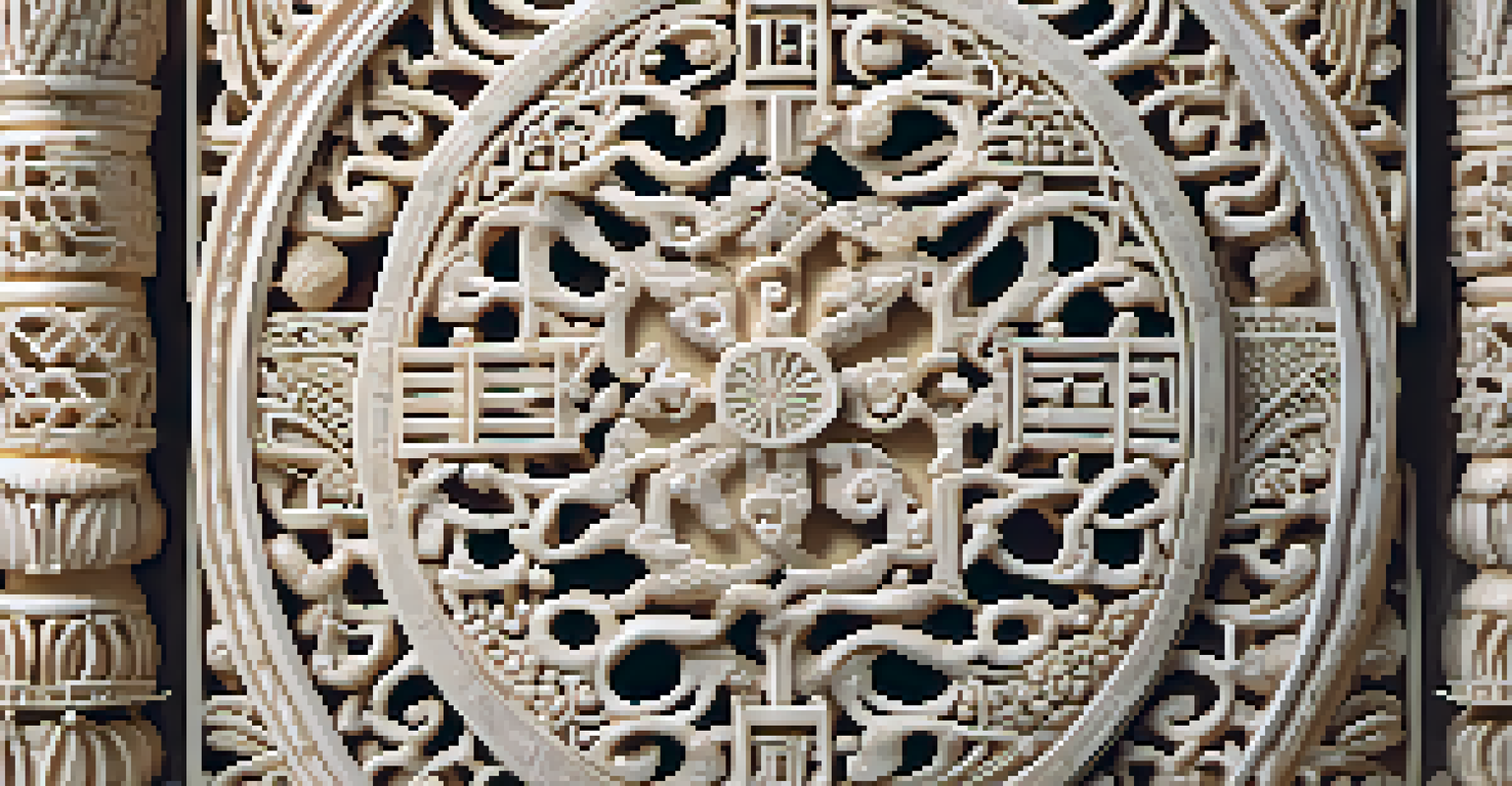Carving in Prehistoric Societies: Tools and Methods

Understanding the Importance of Carving in Prehistoric Cultures
Carving played a vital role in prehistoric societies, serving both functional and artistic purposes. It allowed early humans to create tools, decorative items, and even spiritual artifacts. This blend of practicality and aesthetics reflects the values and beliefs of these ancient cultures, showcasing their creativity and ingenuity.
Art is the most beautiful of all lies.
From functional tools like spears and knives to intricate figurines, carving was a way to express identity and community. Each carved piece tells a story, revealing insights into daily life, rituals, and the environment. By studying these artifacts, we gain a deeper understanding of the social dynamics and cultural practices of our ancestors.
Moreover, carving techniques often varied by region, influenced by local materials and cultural exchanges. This diversity highlights how prehistoric societies adapted to their surroundings while still engaging in shared practices of creation and expression.
Tools Used for Carving in Prehistoric Times
The tools of prehistoric carvers were often simple yet remarkably effective. Early humans utilized materials like stones, bones, and wood to create basic chisels, scrapers, and knives. These rudimentary tools were essential for shaping and detailing their carvings, demonstrating the resourcefulness of our ancestors.

Flintknapping, the process of chipping away at stone to create sharp edges, was a common method for making carving tools. This skill required practice and precision, as the quality of the tool directly impacted the carver's ability to create intricate designs. Over time, different cultures developed unique styles of tool-making, contributing to their distinct artistic expressions.
Carving Reflects Culture and Identity
Prehistoric carvings served both functional and artistic purposes, reflecting the values, beliefs, and social dynamics of ancient societies.
In addition to stone tools, natural elements such as animal bones and antlers were also repurposed for carving. These materials not only provided the necessary hardness for detailed work but also allowed for a connection to the environment, as they often came from the animals that the communities hunted.
Carving Techniques in Prehistoric Art
Prehistoric carving techniques varied significantly across different cultures, each developing their own methods over time. Techniques like relief carving, where figures are raised above the background, and intaglio, where designs are incised into a surface, showcased the versatility of early artists. These methods allowed for creative expression while also serving functional purposes.
The past is never dead. It's not even past.
An excellent example of relief carving can be seen in the intricate designs found on many ancient totem poles. Such carvings not only depicted stories and symbols significant to the culture but also served as markers of identity and heritage. Similarly, intaglio techniques were often used in the creation of tools, where grooves and patterns enhanced both grip and utility.
These artistic choices reflect the values and beliefs of the societies that created them, offering a glimpse into their worldview. The integration of form and function in prehistoric art illustrates how practicality and creativity were intertwined, creating a legacy that continues to influence modern artisans.
The Symbolic Meaning Behind Prehistoric Carvings
Many carvings from prehistoric societies held deep symbolic meanings, often tied to spirituality and community identity. For instance, animal figures carved from stone or wood were not just artistic representations but also served as totems, embodying the spirit of the animal and its significance to the tribe. These carvings often played a role in rituals and ceremonies, linking the community to their beliefs.
Additionally, carvings of human figures or abstract symbols could represent ancestors or deities, reinforcing cultural narratives and traditions. Such symbolism was crucial for maintaining a sense of continuity and connection among community members, as these artifacts helped transmit values and stories through generations.
Diverse Tools and Techniques Evolved
Early humans developed various tools and techniques for carving, showcasing their resourcefulness and adaptability to local materials.
As we explore these carvings today, we uncover layers of meaning that reveal how prehistoric peoples understood their world. Each carved piece invites us to consider the beliefs and experiences of those who came before us, emphasizing the importance of storytelling in human history.
The Materials Used for Carving
The choice of materials for carving in prehistoric societies was often dictated by availability and purpose. Stone, particularly flint and sandstone, was favored for its durability and sharpness, making it ideal for crafting tools and intricate designs. The local environment played a crucial role in determining what materials were used, showcasing the adaptability of these ancient societies.
In addition to stone, organic materials such as wood, bone, and ivory were also commonly carved. Wood was particularly versatile, allowing for both functional items like bowls and decorative pieces. The use of bone and ivory reflected a deeper connection to the animals hunted, as these materials were often repurposed to create meaningful artifacts.
The variety of materials highlights the resourcefulness of prehistoric peoples, demonstrating their ability to utilize their surroundings effectively. This ingenuity not only facilitated survival but also fostered a rich tradition of artistic expression that continues to captivate us today.
Preservation of Prehistoric Carvings
Preserving prehistoric carvings is essential for understanding our ancient past, yet it poses significant challenges. Many carvings have been eroded by time, weather, and human activity, making it difficult to study and appreciate their original beauty. Efforts to conserve these artifacts often involve careful excavation and controlled environments to protect them from deterioration.
In recent years, advancements in technology have aided preservation efforts. Techniques like 3D scanning and digital modeling allow researchers to create virtual replicas of carvings, ensuring that even deteriorated pieces can be studied and appreciated. These innovations not only help protect the physical artifacts but also make them accessible to a broader audience.
Prehistoric Influence on Modern Art
The artistic practices of prehistoric carving continue to inspire modern artists, fostering a dialogue between ancient and contemporary expressions.
Moreover, public awareness and education are key to preserving these cultural treasures. By fostering a greater appreciation for prehistoric carvings, we can encourage responsible tourism and support initiatives aimed at protecting these invaluable links to our history.
The Influence of Prehistoric Carving on Modern Art
The legacy of prehistoric carving continues to influence contemporary art, as modern artists draw inspiration from ancient techniques and styles. By examining the simplicity and depth of these early works, artists today can explore themes of identity, nature, and spirituality in their own creations. This connection to the past adds layers of meaning to modern art, creating a dialogue between eras.
Many contemporary sculptors and artisans utilize traditional carving methods, revitalizing ancient practices while infusing them with modern sensibilities. This blend of old and new not only honors the craftsmanship of prehistoric societies but also challenges us to think critically about our own artistic expressions and cultural narratives.

Furthermore, exhibitions showcasing prehistoric carvings remind us of our shared human experience. As we engage with these ancient works, we are invited to reflect on the universal themes of creativity, survival, and connection that resonate across time and cultures.